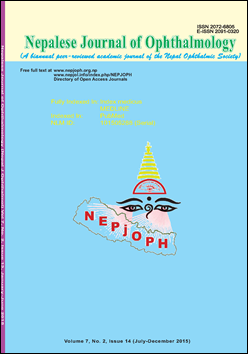Dynamic Magnetic Resonance Imaging- a sensitive tool in managing consecutive exotropia
DOI:
https://doi.org/10.3126/nepjoph.v7i2.14991Keywords:
Consecutive exotropia, dynamic MRI, esotropia, medial rectus advancement, slipped muscleAbstract
Background: Proper evaluation and accurate diagnosis are crucial in managing a case of strabismus.
Objective: Report a case of prolonged large angle complicated consecutive exotropia where dynamic Magnetic Resonance Imaging helped us to diagnose and simplify the management plan.
Case: A 19-year-old male presented with outward deviation of both eyes for last 16 years with right face turn, without diplopia and trauma. However, he had history of two consecutive squint surgeries, a month apart, at the age of 3 years.
Observation: Visual acuity (best corrected) in the right and left eye was 6/36 and 6/6 respectively. Extraocular movements revealed minus (-) 4 adduction deficits in the left eye with right eye suppression. Prism Alternate Cover Test (PACT) showed 65 prism diopter (PD) base in (BI), for primary and near gazes with lateral incommitance and without any pattern. Forced Duction Test (FDT) showed restriction of the left lateral rectus. Dynamic Magnetic Resonance Imaging revealed posterior insertion of the left medial rectus with thinning of the tendinous insertion of the left lateral and medial rectus in neutral position. On adduction of left eye, there was slight increased bulk of the left medial rectus. Medial Rectus (MR) advancement 5.5 mm and Lateral Rectus (LR) recession 9mm was done. Repeat FDT showed improvement in resistance. After 3 month, the patient had excellent outcome with 5 PD primary position exotropia and 2 units of improvement in left eye adduction.
Conclusion: Precise workup and appropriate investigation decreases the undue interventions with excellent outcome in a case of large angle consecutive XT.
Downloads
Downloads
Published
How to Cite
Issue
Section
License
This license enables reusers to copy and distribute the material in any medium or format in unadapted form only, for noncommercial purposes only, and only so long as attribution is given to the creator.




